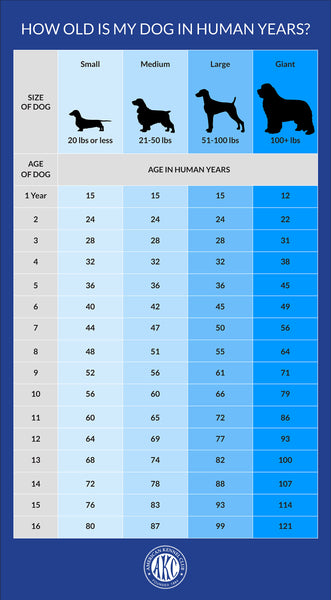Debunking the Myth of Dog Years
Many of us are familiar with the concept that in terms of canine aging, one human year is the equivalent of seven dog years. However, this may just be another common dog myth.
This miscalculated misconception has been around since the 1950s; it was likely based on the statistic that on average, people lived to be about 70 years old, and dogs about 10. It may have also begun as a way to encourage pet owners to bring their dogs to the vet at least once per year.
While it is true that dogs age more quickly than humans, the “seven years” calculation is not necessarily accurate. The reality is that there’s no simple formula for calculating your dog’s “human” age, since different breeds age at different rates. However, it’s still important to at least have a basic understanding of the rate your dog will age so you can be prepared to help him live his life to the fullest.
How to Calculate Dog Years
If you break it down, one dog year could be the equivalent of anything from 4-15 human years depending on the breed and health of your dog. In general, the first year of a dog’s life equals 12-15 human years in terms of development. Everything after that is worth about 4-5 dog years, depending on the dog’s size and stage of life.
For example: after one year, a dog weighing 20 pounds or less would be about 15 years old in human years; a dog weighing 100 pounds or more would be about 12. From there, the small dog and the large dog age at different rates. After 10 years, the small dog would be considered 56 years old in human years, while the large dog would be 79.
See this chart from American Kennel Club for visual reference:

As of right now, there is no clear explanation as to why small dogs tend to live longer than large dogs. One theory is that small dogs tend to be more pampered with a relatively easy going lifestyle, while large dogs tend to be more active, which comes with its own risks. Other researchers attribute the increased likelihood of age-related diseases to the fact that large breeds age more quickly. Size isn’t the only factor to take into consideration, though. Some breeds, such as Bulldogs and Great Danes, age at different rates than their similarly-sized canine peers.
Regardless of your pup’s age and breed, you’ll want to be sure you’re providing him with a healthy diet, plenty of exercise, and lots of love throughout all stages of his life.
A Puppy’s First Year
Depending on the breed, puppyhood can last anywhere from 8 months to two years. The first year of a dog’s life is essential to his development—after all, that’s 12-15 dog years! After just one year, a pup can go from helpless newborn to potential parent.
During his first four weeks of life, warmth and nutrition are crucial. Baby Fido can touch and taste right away, but won’t open his eyes, grow teeth, or develop hearing and smell until two to four weeks later. A puppy’s needs are typically met by his mom during this time.
At about eight weeks old, a puppy is generally ready to go home with his new family, complete with newly-developed social skills and physical coordination. Anywhere from four weeks to three months is ideal for Fido’s first vet visit, so that should be on any new puppy owner’s priority list.
Within three to six months, a puppy will start teething—this is when the chewing starts. This is a good time to begin training, especially as he begins to develop relationships with you and others in the household.
Soon enough, your puppy will become a teenager. Some female pups can get pregnant as early as six months old, so unless you want a litter of even more puppies on your hands, consider spaying or neutering your pup at six to nine months.
Most small dogs will begin to act like adults within 9-12 months, while larger dogs may continue to act like puppies for another year or so (no complaints here!).

Signs Your Dog is Aging
As your dog grows from puppy to senior, you’ll begin noticing physical and mental changes. Common signs your dog is aging include:
- Cloudy eyes, and possible vision loss
- Bad breath, which could indicate gum disease or tooth decay
- Decreased mobility
- Skin changes (new lumps and spots)
- Weight gain or weight loss
- Bathroom issues
-
Canine Cognitive Dysfunction, or dog dementia
PetHonesty’s Anti-Scratch Salmon Oil can help to improve your dog’s skin and coat health, mobility, immunity, digestion, and overall health, and Senior HempMobility Chews support healthy joint function in dogs seven years or older.
Of course, nothing can replace a visit to the vet. Regular vet visits can help to detect, prevent, or slow the progression of age-related issues, so you and your furry friend can truly enjoy his “golden years” together.
Sources:
https://www.akc.org/expert-advice/health/how-to-calculate-dog-years-to-human-years
https://www.petmd.com/dog/general-health/pet-myths-dog-years-human-years
https://priceonomics.com/the-mythology-of-dog-years/
https://www.akc.org/expert-advice/health/physical-mental-signs-dog-aging/
https://petcube.com/blog/puppy-first-year/














